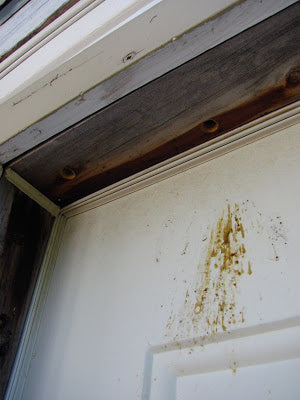Pollen is their main food source and if nest access holes are close to the siding many times their feces will fall directly onto some part of the house.
Carpenter bees residue on siding.
If you wonder the yellow stains around your living space it might be another sign of carpenter bees infestation.
This drilling will many times create a sawdust by product which can leak down siding giving the appearance of droppings or bee feces.
More signs are brownish or yellowish excrement stains below the entrance hole to the galleries.
The carpenter bees will excess feces and leave yellow stain.
Carpenter bee sprays can be applied on and around the holes in the wood and is effective on newer intrusions.
The result is a yellow streak which can have some other colors mixed in.
Carpenter bee kit 3 or carpenter bee kit 9are perfect for larger jobs or homes constructed with cedar siding or logs.
This becomes a chamber where the female lays eggs leaves a food ball of pollen and then seals the chamber.
They have even been found making holes in wooden.
Spray insecticide more heavily in early spring to prevent infestation and then treat regularly throughout the summer.
Additionally bees which remain active in one location will definitely defecate as they drill.
They make holes in siding soffits decks posts and the painted or bare wood of barns and sheds especially when the paint is old hottel says.
This mess is caused by carpenter bee feces and it is incredibly.
They are solitary bees and are not part of a larger hive community.
Pesticides offer an effective means to eliminate the pests.
Instead they burrow into soft woods such as the siding of a house to live in and lay larvae.
Carpenter bees also can left pollen crumb around your furniture.
It sounds like this is what you re seeing.
A hose end type of sprayer is used by pouring 6 to 8 ounces cypermethrin product fill with water hooking it to your garden hose and then depressing the trigger.
However since carpenter bees are not social insects and tend to be more solitary bees getting rid of carpenter bees usually does not involve dealing with a large hive.
The carpenter bee is so called because of where it chooses to make it s home.
If you read through our carpenter bee article you ll learn these bees drill through wood to created nests.
Carpenter bees crawl between cracks in siding and roofing where they bore holes about 1 2 inch wide and 1 or 2 inches long.
As it is their primary food source you can also detect the sign by it.
Ever notice a yellowish brown splatter on the siding of your home perhaps beneath the gutter.
The female carpenter bee is the one who makes the hole by chewing through the wood.




























